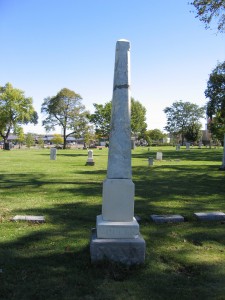Cremations Today and Years Ago at Pioneers and Soldiers
Last year over 40% of all burials in the United States involved cremation. That”'s a number that has been steadily increasing over the years, and, that, given the high cost of funerals, is not likely to decline any time soon. That wasn”'t always the case, however. The vast majority of burials in Minneapolis Pioneers and Soldiers Cemetery were full-casket burials. There are a few cremations (or “cremains,” as the they are sometimes called) but most of those were burials that took place after 1919 when the city passed an ordinance that severely restricted who could be buried in the cemetery.
Before that, cremations were rare. Religious beliefs prevented most people from considering it but there was at least one notable exception.
Harry Hayward, Convicted Murderer, Cremated? Or ?
Harry Hayward, hanged for plotting the murder of Catherine Ging, widely regarded as Minnesota”'s crime of the 19th century, was cremated in 1895, and his ashes were buried near those of other members of his family. The fact that he was cremated undoubtedly contributes to some long-standing confusion about whether and where Harry is buried.
In 1895, after his family held a private memorial service for Harry at Lakewood Cemetery, his body was sent to Chicago to be cremated. Minneapolis did not have a crematorium at the time. Conspiracy theorists (and there were plenty of them) believed that Harry”'s hanging was faked and that he made it to Chicago under his own power and lived there until he died. Others assumed that since the memorial service took place at Lakewood, that”'s where Harry was buried. (You”'ll just have to trust me on this for the moment, but I assure you that Harry”'s ashes are buried in Minneapolis Pioneers and Soldiers Cemetery).
Eilert Mollan”'s “Dust” is like a “Shell Game” (under which of three shells is the pea?)
The same cannot be said with any certainty about the ashes of Eilert Mollan (see May 2013 Alley story about his daughter Ada).
Eilert died March 12, 1926. He was cremated and his ashes supposedly were buried in the same block of graves as his son Adolph, two infant granddaughters and Eilert”'s first two wives.
Eilert Mollan was born in Norway in 1851. He and his wife Marie had four children in Norway and another daughter after they came to the United States. Two of their children died before the family emigrated but their son Adolph and daughter Ada made the trip with them. Eilert worked with wood and was variously described as a carpenter or a wood turner.
His wife and daughter ran a private hospital for people suffering from mild forms of mental illness (See The Alley, May 2013 page 3, “Ada Mollan, A Pioneer of Mental Health Aid”). His first wife Marie died on March 20, 1907, after having undergone surgery for gallstones. On February 26, 1909, Eilert married Karine Nelson; she died slightly over one year later on March 14, 1910, from typhoid fever.
On April 15, 1911, Eilert married for a third time. His wife was Louise Lee, and she did not get along with his daughter, Ada. After Eilert died in 1926, Ada sued Eilert”'s widow over the disposition of his estate claiming that Louise had used undue influence on Eilert that resulted in him becoming estranged from other members of his family. Ada prevailed. Four years later, Louise Mollan appealed that decision. Court documents from the appeal describe Mollan “as a sturdy character not easily crossed in his purposes and not easily influenced,” and summarized the state of his marriages as “happy in his first marriage and in his second marriage. After his third marriage in 1911, there is evidence that his wife dominated him.” There was no question that Louise had helped him out financially and had stayed with him during a protracted illness until his death. Nonetheless, there was “garrulous and gossipy” evidence that supported Ada”'s claim that Louise had alienated Eilert from his family. Ada”'s win was upheld.
Cemetery records indicate that Eilert was cremated and the thought, at least initially, was that he was buried in the family plot. There is a card that has a note that says that an urn containing Eilert”'s ashes is in his wife”'s casket (presumably referring to his first wife, but possibly his second). On the back of that card there is another note, written by one of the cemetery”'s former caretakers, that Eilert”'s daughter (Ada) proved the urn was empty. That”'s all it says. It doesn”'t say how she proved it or say where his ashes are.
Louise Lee Mollan died from bronchial pneumonia on December 4, 1943; she was 81 years old. She is also buried in Minneapolis Pioneers and Soldiers Cemetery but not in the Mollan family plot. She is buried in another section of the cemetery with members of her family. Whether or not Eilert is one of them, we don”'t know.
*”˜Ashes to ashes”' derives from the English Burial Service. The text of that service is adapted from the Biblical text, Genesis 3:19 (King James Version).Â
The term has been used frequently in literature and song lyrics. Ashes to Ashes is the title of a 2009 BBC television series. It was also used as a song title by David Bowie in 1980, which included one of his best-known lyrics:
Ashes to ashes, funk to funky We know Major Tom”'s a junkieÂ
In the sweat of thy face shalt thou eat bread, till thou return unto the ground; for out of it wast thou taken: for dust thou art, and unto dust shalt thou return.
”“ Biblical text, Genesis 3:19 (King James Version)










